Publication
Protecting Your Financial Interests Should a Customer or Supplier go Insolvent
In these uncertain times - in fact, in any times - insolvency proceedings can be initiated without warning by anyone, from a small local company to a large national or international corporation. In any of these situations, it is important to be diligent about protecting your financial interests. We outline the three most common filing processes for an insolvent person or company (“Debtor”), and what a claimant (“Creditor”) must do to preserve its rights to make a claim (“Claim”) and recover its Claim (or at least a share of the proceeds) in the insolvency proceeding.
Formal insolvency proceedings in Canada can be commenced by a Debtor in one of three separate processes. If a customer files a Creditor Claim using one of the following proceedings it does not necessarily mean that you are out of luck with recovery, it just means you must take prompt action at the outset of any of the processes and file a Claim properly and on a timely basis. The time deadlines will vary depending on which of the three processes are used.
- Filing under the Companies Creditors Arrangement Act (“CCAA”)
The CCAA is a federal act that allows companies anywhere in Canada which are experiencing financial trouble, an opportunity to restructure their affairs to avoid bankruptcy, and for creditors to receive some form of payment. On the Alberta Court of Queen’s Bench website there is the “model” CCAA initial order (“Initial Order”), which sets out the usual terms of the Order granted to a Debtor applying for protection in such a CCAA proceeding. The Initial Order form sets out the terms and the guidelines of the CCAA proceeding, including detailed rules about the process for filing Claims, and (most importantly) will set a deadline by which all Creditors must file details of their Claim, called a Claims Bar Date. Once a company has filed for protection under the CCAA and obtained the Initial Order (which is usually for 30 days but is routinely extended), all claims and lawsuits are stayed while the Debtor company prepares a Plan of Arrangement, which is the proposal that the company presents to its creditors on how it intends to restructure its debt owed at the time of the initial filing. As part of the process, a Monitor is an independent third party who is appointed by the Court to monitor the Debtor’s continuing operations and to assist with the preparation, filing and voting on the Plan of Arrangement.
Although there is, as noted, a Claims Bar Date for the filing of Creditor Claims in the CCAA proceeding, all is not necessarily lost if a Creditor forgets or neglects to file on time. In what is now the leading case on such “Late Claims”, Jeff Thom was successful at the Supreme Court of Canada (SCC) in the case Blue Range Resource Corp., Re 2001 Carswell Alta 1209, SCC where he succeeded in his two clients being allowed to file and recover such Late Claims, despite missing the Claims Bar Date.
The current Late Claims test which the courts now apply, as reinforced by that Blue Range decision, emphasizes that there must be a good reason for the inadvertent late filing of the Creditor Claim, that the Creditor must be filing its Claim in good faith, and that there be a balancing of any prejudice to other Claimants or the Debtor against the equities of allowing the Creditor’s Late Claim to be filed in the CCAA proceeding.
Having said that, Jeff Thom counsels all Creditors to file their Claim on time, as a Late Claim is more expensive to pursue than one filed on time before the Claims Bar Date, and does need favourable facts for it to be allowed by the CCAA Court. - The appointment of a Receiver or Receiver/Manager
A Receiver or a Receiver/Manager, usually an accounting firm or other independent party, can be appointed in different ways and in diverse situations. Typically, the appointment of a Receiver is done by a Court Order on notice to the Debtor (or in urgent situations without any notice at all) at the application of a secured creditor under a security agreement, although Receivers are appointed and used in different situations which call for Court assistance in preserving assets where it is alleged that the Debtor is unlikely to properly deal with all of its Creditors’ Claims to those assets. The usual Receivership Order is the Model Order which is also on the Court of Queen’s Bench website.
The receivership process can become quite complicated, and there are many different types of secured, unsecured, and trust-type claims, so we recommend reaching out to someone on our team to help you through the process to make sure that your Creditor Claim to any assets is properly filed with the Receiver and the Court, and that your Claim is given its proper priority. - An assignment or petition into Bankruptcy
Another federal statute which allows insolvent Debtors to reorganize is the Bankruptcy and Insolvency Act (BIA). There are three separate processes under the BIA in which a company or person can become involved, either by filing voluntarily (or by a creditor petitioning the Debtor into the Bankruptcy process), which are:
- Proposal - A proposal under the BIA is a legally binding arrangement negotiated with a company’s creditors through what is called a “Licensed Insolvency Trustee”. Once a Notice of Intention (“NOI”) is filed by a Debtor, there is an immediate 30 day stay of proceedings (extendable for up to 6 months) which provides the Debtor with immediate protection from unsecured creditors (i.e. debt collectors), and allows the Debtor time to reorganize to present a Proposal to its creditors to avoid bankruptcy. A successful Proposal allows a Debtor to keep control of their assets while unsecured creditors agree to accept a lesser sum than is owing to them in satisfaction of their original claim, if it appears to the voting Creditors that such a Proposal will give them more return than a Bankruptcy. In a Proposal, all Creditors must file their Claims on a timely basis, and all then get to vote on the Proposal presented by the Debtor.
- Petition - A petition is where creditors petition the Court to make a declaration that the Debtor is bankrupt, in situations where they can show that the Debtor cannot pay its debts when due. In that case the Court appoints a Licenced Bankruptcy Trustee to take over the Debtor’s business and its property, to administer and sell them for the general benefit of the creditors.
- Assignment - An assignment into bankruptcy is done by the Debtor itself, rather than creditors, but otherwise the result is similar to a Petition where the Court appoints a Licensed Bankruptcy Trustee to take over the operation of the Debtor so that the assets and property can be sold for the general benefit of the creditors.
In either a Petition or an Assignment into bankruptcy, all creditor Claims must be filed with the Trustee, and are allocated by the Trustee for payment in a priority set by the BIA Statute.
If you receive formal or informal notice, or become aware, of an insolvency proceeding involving a Debtor which owes you money, it is important to understand your legal position, and also to file your Claim on a timely basis. Feel free to contact any member of our experienced Bankruptcy, Insolvency & Restructuring team, and we will help guide you through the particular process involved.

